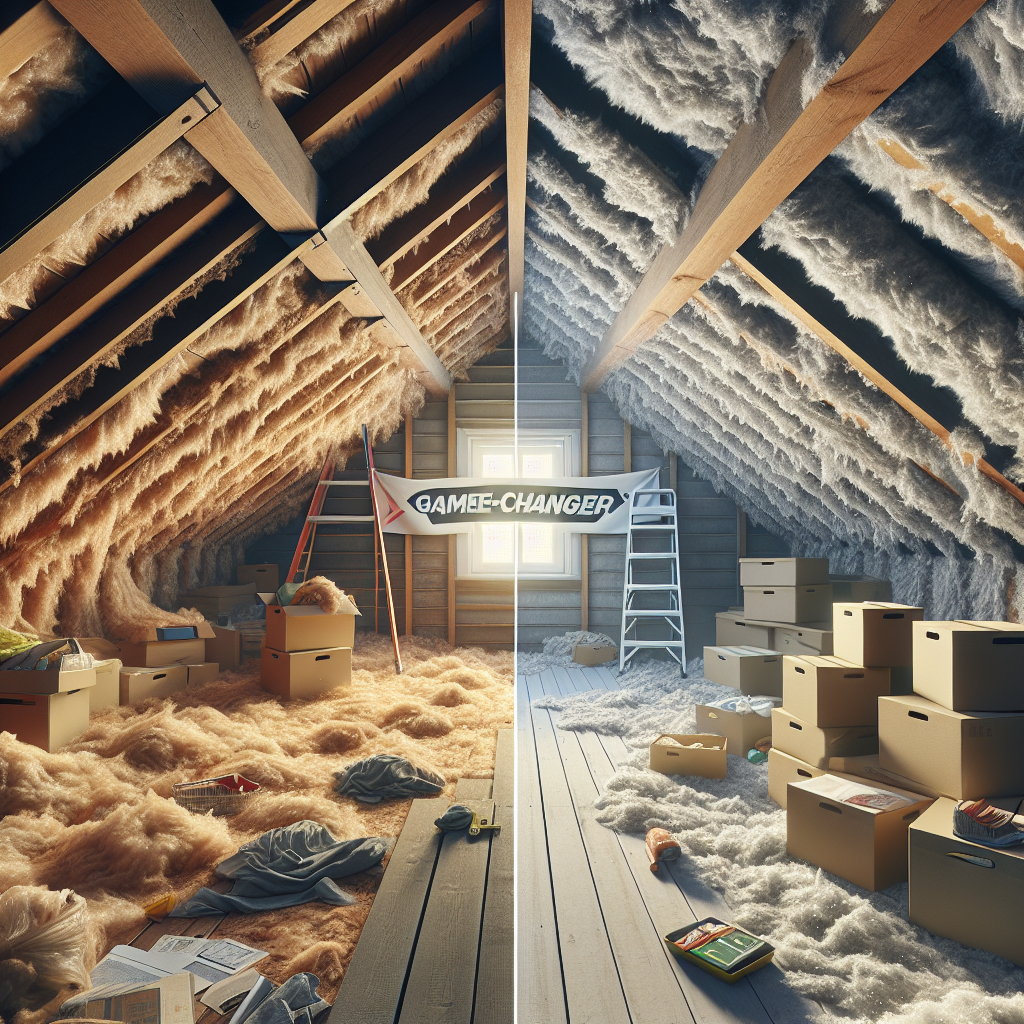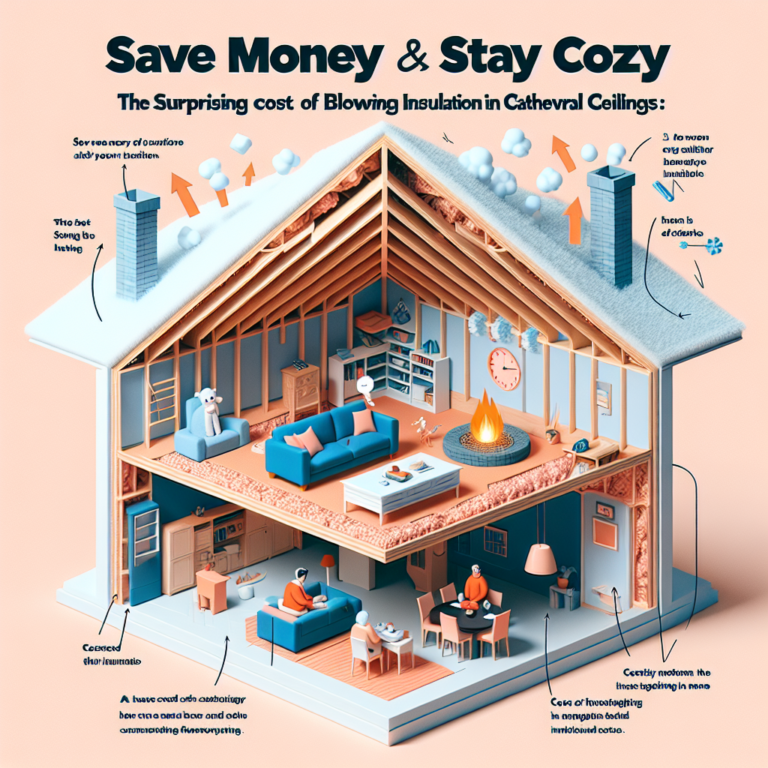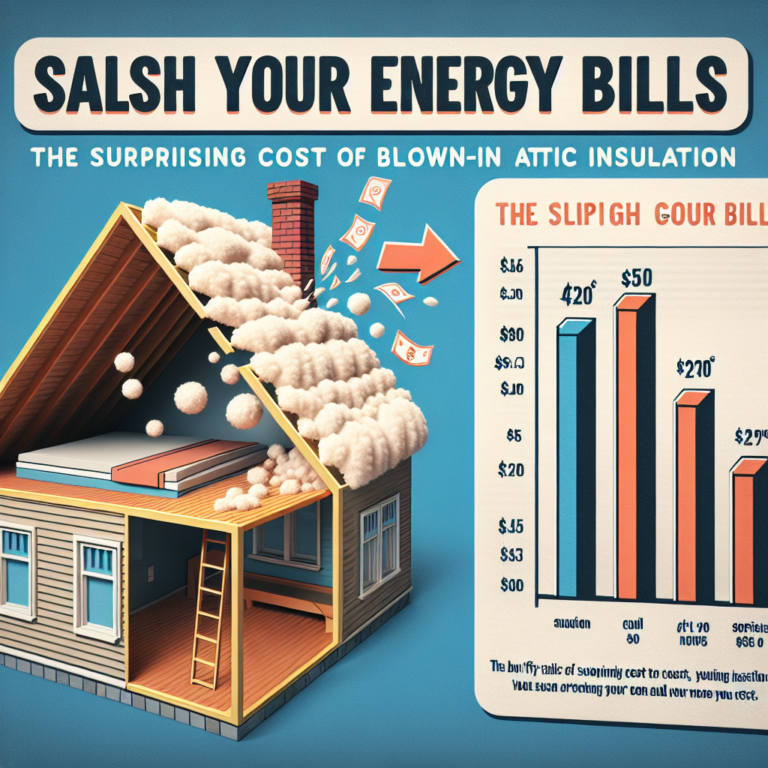-
Table of Contents
“Efficiently insulate your home with blown in insulation – keeping you warm in the winter and cool in the summer.”
Upgrade your home’s insulation with blown in insulation and experience increased energy efficiency and cost savings. Visit texasinsulationsolution.com to learn more and schedule your installation today!” Click here to get started.
Introduction
Blown-in insulation is a type of insulation that is installed by blowing loose fibers or particles into a space, such as an attic or wall cavity. It is a popular method of insulating homes and buildings due to its ease of installation and ability to fill small or irregularly shaped spaces. This type of insulation can help improve energy efficiency, reduce noise, and provide better temperature control in a building. In this introduction, we will explore the basics of blown-in insulation and its benefits.
Benefits of Blown-In Attic Insulation for Energy-Saving Homes
Blown-in insulation, also known as loose-fill insulation, is a popular choice for homeowners looking to improve the energy efficiency of their homes. This type of insulation is made up of small particles of materials such as fiberglass, cellulose, or mineral wool, which are blown into the attic space using specialized equipment. Blown-in insulation offers several benefits for energy-saving homes, making it a top choice for many homeowners.
One of the main benefits of blown-in insulation is its ability to provide excellent coverage and fill in any gaps or voids in the attic space. Unlike traditional batt insulation, which comes in pre-cut sheets, blown-in insulation can be easily distributed and blown into hard-to-reach areas, ensuring that every nook and cranny is properly insulated. This means that there are no gaps for air to escape or enter, making it a more effective option for energy-saving homes.
In addition to its superior coverage, blown-in insulation also has a higher R-value compared to other types of insulation. R-value is a measure of an insulation material’s ability to resist heat flow, and the higher the R-value, the better the insulation’s thermal performance. Blown-in insulation has a higher R-value per inch, making it a more efficient choice for energy-saving homes. This means that homeowners can achieve the same level of insulation with less material, making it a cost-effective option in the long run.
Another advantage of blown-in insulation is its ability to reduce air leakage. Air leakage is a major cause of energy loss in homes, as it allows warm air to escape during the winter and cool air to enter during the summer. Blown-in insulation creates a tight seal in the attic space, preventing air from escaping or entering, thus reducing the workload on heating and cooling systems. This not only leads to energy savings but also helps to maintain a comfortable temperature inside the home.
Furthermore, blown-in insulation is an eco-friendly option for energy-saving homes. The materials used in blown-in insulation are often made from recycled materials, making it a sustainable choice for homeowners. Additionally, the installation process of blown-in insulation produces less waste compared to other types of insulation, making it a more environmentally friendly option. This is especially important for homeowners who are looking to reduce their carbon footprint and make their homes more eco-friendly.
Aside from its energy-saving benefits, blown-in insulation also offers other advantages for homeowners. One of these is its ability to reduce noise levels inside the home. The dense particles of blown-in insulation act as a sound barrier, reducing the amount of noise that can enter or escape the home. This is particularly beneficial for homes located in noisy areas or near busy roads.
In conclusion, blown-in insulation offers numerous benefits for energy-saving homes. Its superior coverage, high R-value, and ability to reduce air leakage make it a more efficient option compared to other types of insulation. It is also an eco-friendly choice and can help reduce noise levels inside the home. With its many advantages, it’s no wonder that blown-in insulation is a top choice for homeowners looking to improve the energy efficiency of their homes.
How Blown-In Insulation Can Improve Your Home’s Energy Efficiency

Blown-in insulation is a popular and effective method of insulating homes. It involves using loose, lightweight materials such as fiberglass, cellulose, or mineral wool, which are blown into the walls, attic, or other spaces in a home. This type of insulation is gaining popularity due to its many benefits, including improved energy efficiency. In this article, we will explore how blown-in insulation can improve your home’s energy efficiency and why it is a smart investment for any homeowner.
One of the main reasons why blown-in insulation is so effective in improving energy efficiency is its ability to fill in gaps and crevices that traditional insulation methods may miss. These small openings can allow air to leak in and out of a home, causing drafts and making it difficult to maintain a consistent temperature. Blown-in insulation can easily fill these gaps, creating a more airtight seal and preventing air from escaping or entering the home.
Furthermore, blown-in insulation has a higher R-value compared to other types of insulation. R-value is a measure of an insulation material’s ability to resist heat flow. The higher the R-value, the better the insulation’s thermal performance. Blown-in insulation has a higher R-value per inch, meaning it can provide better insulation with less material compared to other types of insulation. This makes it a more cost-effective option for homeowners looking to improve their home’s energy efficiency.
Another advantage of blown-in insulation is its ability to conform to any space. Unlike traditional insulation, which comes in pre-cut sizes and shapes, blown-in insulation can be easily blown into any space, no matter how small or oddly shaped it may be. This makes it an ideal choice for insulating attics, walls, and other hard-to-reach areas. By filling in all the nooks and crannies, blown-in insulation can create a more complete and effective thermal barrier, reducing heat loss and improving energy efficiency.
Moreover, blown-in insulation is a more environmentally friendly option compared to other types of insulation. It is made from recycled materials, such as shredded newspaper or recycled glass, making it a sustainable choice for homeowners. Additionally, blown-in insulation does not contain any harmful chemicals or toxins, making it safe for both the environment and the occupants of the home.
In addition to improving energy efficiency, blown-in insulation can also help reduce noise levels in a home. The dense and compact nature of blown-in insulation can act as a sound barrier, reducing the amount of noise that enters or leaves a home. This can be especially beneficial for homeowners living in noisy areas or near busy roads.
Furthermore, blown-in insulation is a long-lasting solution for improving energy efficiency. Unlike traditional insulation, which can settle and lose its effectiveness over time, blown-in insulation maintains its shape and density, providing consistent insulation for many years. This means that homeowners do not have to worry about replacing or adding more insulation in the future, making it a cost-effective and hassle-free option.
In conclusion, blown-in insulation is a highly effective and efficient method of improving a home’s energy efficiency. Its ability to fill in gaps, high R-value, versatility, eco-friendliness, noise reduction, and long-lasting performance make it a smart investment for any homeowner. By choosing blown-in insulation, homeowners can not only save money on their energy bills but also contribute to a more sustainable and comfortable living environment.
The Process and Cost of Installing Blown-In Attic Insulation for Energy-Saving Purposes
Blown-in insulation is a popular method for insulating attics and walls in homes. It involves using a machine to blow loose insulation material, such as fiberglass or cellulose, into the desired space. This type of insulation is known for its energy-saving benefits and is a cost-effective option for homeowners looking to improve their home’s energy efficiency.
The process of installing blown-in insulation is relatively simple and can be completed in a matter of hours. The first step is to prepare the space by clearing any debris or obstructions. This includes removing any existing insulation, if necessary, and ensuring that the area is clean and free of any potential hazards.
Next, the insulation material is loaded into the machine and blown into the space using a high-pressure air hose. The machine evenly distributes the insulation, filling in any gaps or voids and creating a seamless layer of insulation. This method allows for a more thorough and efficient coverage compared to traditional methods, such as batt insulation.
One of the main advantages of blown-in insulation is its ability to conform to any space, regardless of size or shape. This makes it an ideal option for attics with irregular shapes or hard-to-reach areas. The insulation material can also be blown over existing insulation, providing an extra layer of protection and increasing the overall R-value (a measure of insulation’s effectiveness).
In addition to its energy-saving benefits, blown-in insulation also offers soundproofing qualities. The dense material helps to reduce noise transmission, making it a popular choice for homeowners living in noisy areas or near busy roads.
When it comes to cost, blown-in insulation is a budget-friendly option compared to other types of insulation. The cost of materials and installation is typically lower, making it an attractive choice for homeowners on a tight budget. Additionally, the energy savings from improved insulation can lead to long-term cost savings on heating and cooling bills.
The cost of installing blown-in insulation can vary depending on factors such as the size of the space, type of insulation material, and the location of the home. On average, homeowners can expect to pay between $1,500 to $2,500 for a professional installation. However, this cost can be significantly lower for smaller spaces or DIY installations.
It is important to note that while blown-in insulation may have a higher upfront cost compared to other types of insulation, its long-term benefits make it a worthwhile investment. The improved energy efficiency can lead to significant savings on heating and cooling costs, making it a cost-effective choice in the long run.
In addition to its energy-saving benefits, blown-in insulation is also environmentally friendly. The materials used, such as recycled paper or fiberglass, are non-toxic and do not emit harmful chemicals into the air. This makes it a safe option for both homeowners and the environment.
In conclusion, blown-in insulation is a highly effective and cost-efficient method for insulating attics and walls. Its ability to conform to any space, energy-saving benefits, and soundproofing qualities make it a popular choice among homeowners. While the initial cost may be higher, the long-term savings and environmental benefits make it a worthwhile investment. If you are looking to improve your home’s energy efficiency, consider blown-in insulation as a viable option.
Q&A
Q: What is blown in insulation?
A: Blown in insulation is a type of insulation material that is installed by blowing it into walls, attics, or other spaces using specialized equipment. It is typically made of materials such as fiberglass, cellulose, or mineral wool and helps to improve the energy efficiency of a building by reducing heat loss or gain.
Q: How is blown in insulation installed?
A: Blown in insulation is installed using a machine that blows the insulation material into the desired space. The material is typically blown through a hose and distributed evenly to create a layer of insulation. The process can be completed by a professional insulation contractor or by renting the equipment and doing it yourself.
Q: What are the benefits of blown in insulation?
A: Blown in insulation offers several benefits, including improved energy efficiency, reduced utility bills, and increased comfort in the home. It can also help to reduce noise levels and improve indoor air quality by reducing drafts and preventing the entry of outdoor pollutants. Additionally, blown in insulation is a cost-effective and environmentally friendly option for insulating a home.
Conclusion
In conclusion, blown-in insulation is a highly effective and efficient method of insulating homes and buildings. It offers numerous benefits such as improved energy efficiency, reduced utility costs, and increased comfort. It is also a cost-effective option compared to other insulation methods and can be easily installed in hard-to-reach areas. Additionally, blown-in insulation is environmentally friendly and can help reduce carbon footprint. Overall, it is a great choice for homeowners and building owners looking to improve the insulation of their properties.






